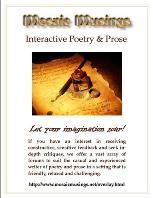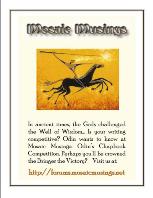 Oct 12 07, 09:06 Oct 12 07, 09:06
Post
#1
|
|
|
Group: Gold Member Posts: 11,722 Joined: 15-June 07 From: Springfield, Louisiana Member No.: 446 Real Name: Larry D. Jennings Writer of: Poetry & Prose Referred By:Just wondered in. |
Revision #2 (thanks to Mary, Merlin & Amythyst)
Words Strange lines, woven together in an odd, haphazard way, are writhing on with twists and turns. Across the centuries they’re painted, coarsely carved in caves; all meaning lost today, or finely penned on parchment in precise calligraphy‘s revealing goodness, evil, love or hatred, truth or lies; reside where they’re ensconced, awaiting one who understands. When heralding a birth or etched in stone at one’s demise, each line is new. Though used before by many different hands; they’re easily affordable to paupers and to kings. The cost is naught but knowledge of their structure and portent. Lines neither know the smiles or tears their convolution brings, nor wait, with baited breath, returns, from where they’re sometimes sent. From animal caricatures to geometric forms, these lines give meaning to a thought, a way, a time or place. Linguistically elusive, yet their shape, like mother’s arms; when understood, brings to the mind the Words in warm embrace. Dedicated to Wordsmiths everywhere and everywhen. ·······  ······· ·······When power leads man toward arrogance, poetry reminds him of his limitations. When power narrows the areas of man's concern, poetry reminds him of the richness and diversity of his existence. When power corrupts, poetry cleanses.
John Fitzgerald Kennedy Kindness is a seed sown by the gentlest hand, growing care's flowers. Larry D. Jennings MM Award Winner    |
|
|
|
 |
Replies
 Oct 26 07, 23:11 Oct 26 07, 23:11
Post
#2
|
|
|
Group: Gold Member Posts: 11,722 Joined: 15-June 07 From: Springfield, Louisiana Member No.: 446 Real Name: Larry D. Jennings Writer of: Poetry & Prose Referred By:Just wondered in. |
Hello Mary, Merlin & Amethyst,
Now that is what I am looking for in critiques...Substance and Reasoning! If I may, let me answer you all as a group. Yes Mary, we have met "online" but never in person. Some years ago, you invited me to join Tenderbytes. Does that jog your memory? The longest poem… Now to your nits: Mary’s Nit #1 & #1A Way too many thes, theys, and variations thereof. Those lazy little pronouns will gang up by the water cooler all day if you allow it -- replace 'em with working words. With the exception of the bits quoted above, the poem tells rather than shows. Don’t they though! Three “the’s” or variations in both sentences. The lines, all strung together in a strange haphazard way I think there are better adjectives to describe well-crafted lines, but maybe that's not what you have in mind. Even so, you need a comma after strange. Seems like you all attacked V1L1-4. I was looking at these "lines" (not well crafted lines of words) , merely lines (----------) through the eyes of ignorance or illiteracy. If one does not understand what the lines form, they are strange and haphazardly connected; not finely penned. Even a finely penned group of words looks incomprehensible to someone who has no knowledge of their meaning. If reworded in the following manner, it may alleviate the confusion: Strange lines, woven together in an odd, haphazard way, are writhing on with twists and turns. Across the centuries they’re painted, coarsely carved in caves, all meaning lost today. Lines finely penned on parchment in precise calligraphy’s, Nit #2: Some tell of good and evil, love and hate, or truth and lies; are resting where they're placed, awaiting one who understands. There's something wrong with this sentence. If you take away the modifying clauses, you have "Some tell ... are resting." Easily fixed, but I'm not going to suggest a fix and deprive you of the joy of finding your own. Some...are resting, not Some tell...are resting. Again, confusion caused by punctuation. Maybe I shouldn't use "Some" at all. Let’s try this… revealing goodness, evil, love or hatred, truth or lies; reside where they’re ensconced, awaiting one who understands. Nit #3 forever new but used before by many different hands. Are words used by hands? Penned by hands, used by minds, I would think. I am talking about the "lines" which form words, not the "words" themselves. I am talking about the lines formed (or used) by one’s hand to create words. So yes, hands do use words; as do mouths. Minds merely tell mouths and hands how to use those lines to make recognizable words, symbols or understandable drawings. I think everyone is seeing “lines” but are reading “words” instead. S1L1 lets the reader know that the lines which form words is what the poem is all about. Nit #4 They neither know the smiles nor tears their convolution brings, or wait with baited breath, returns, from where they're sometimes sent. This is pretty convoluted in itself, Larry. It doesn't make sense to me. "They neither know ... or wait ... returns?" Are you intending "returns" as a verb or a noun? Seems a long way around to express the idea that words don't have an emotional investment in us. Is that anywhere close to what you're saying? Returns, in this context, is a noun…Answers/Return Mail/etc. Once again, you are reading “words” into your thoughts. Read “lines”. I didn’t get my “or” and “nor” in the right places so that may have added to your confusion. Would “Lines” be a better title? I’ll try it the following way and see if that doesn’t clarify the thought. Lines neither know the smiles or tears their convolution brings, nor wait, with baited breath, returns, from where they’re sometimes sent.. Nit #5 From animal caricatures to geometric forms, How do you scan this line, Larry? Unless you pronounce caricature in a way I've never heard, your meter goes south here. from AN / i mal / CAR i / ca TURES ... I assume you are referring to stressed and unstressed syllables. The actual pronunciations from both Webster’s and Roget’s stress only the first syllable in each word. “An uh mal / Kar uh kuh churs” I was simply trying to get rid of some of the “Ta da, Ta da, Ta da”. The line does contain seven metric feet, however those words are pronounced and stressed or unstressed, and is therefore perfect heptameter. Mary & Amethyst’s Nit #6: Linguistically elusive, yet their shape, like mother's arms; when understood, brings to the mind the Words, in warm embrace. Mary's...Are you saying the shape of the words is like mother's arms? The words' shape brings the words to mind? I'm lost. Amethyst's...I didn't read through all of your responses received, but scanned some and I do agree with Mary that L3/L4 lose me a bit. I know what you are saying, but felt it can be expressed with more clarity. Let’s try this without being poetic. Once again, I am writing about “lines” and the shapes utilized to form words. The shape of the “lines”, not the words themselves, are linguistically elusive until one understands what is being written and the meaning thereof. When understood, the mind warmly embraces the words formed by those lines and figuratively hugs them in recognition like a mother embracing her child. Merlin’s Nit #1: Let me attack V1, since the beginning is most important anywhere, and I feel yours needs a bit more work. I get lost completely with the semis, so lets park them, ok. The semicolon problem is/has been solved by rewriting V1, taking out some of the punctuation marks and adding clarity (I hope). Why don't you say, The lines, all strung together in a strange, haphazard way are writhing on with twists and turns across the centuries, from coarsely carved to finely penned, their meaning lost today, inside a cave on parchments in precise calligraphy. Merlin, did you carefully read what you wanted me to change L4 to read? I doubt you will find very many parchments with or without precise calligraphy inside a cave. This may not be what you meant but it is how the sentence reads. Besides, there are too many comma’s in a row. Semicolons should be used in long sentences; especially when utilized between coordinate clauses not connected by coordinate conjunctions. Merlin’s Semi-Nit #2: It would be "calligraphies", but since it is already a word describing multiple things, (like family, group, herd, etc) plural isn't necessary. For this reader, I'll gladly allow that slant rhyme to pass. You do have a poetic license, don't you? Your allowances are appreciated and I concur with your reasoning. It matches my research into that particular word’s usage and how it should be used in both singular and plural contexts. My poetic license is paid in full and utilized often. Amethyst’s Nit #1: However, at end of L3 and L4 ... I felt that what you were trying to say was that in origins when writing was figures and drawings to represent what we now use letters and words to express ... those original ways to write and express have been lost as we now use parchment and the delicacy of calligraphy. I think I kept wanting to say ... those drawings, carved within a cave, hold no meaning today/ to finely penned ... I was trying to say that throughout history, mankind & womankind (:->) have used “lines” to form pictograms, symbols, animals, words, etc. to relate a message and pass on to others what they were thinking. Those original ways to write are only “lost” if one does not know the meaning of what is formed by those “lines” or how to translate the words/pictograms formed by the usage of the “lines” in shaping them. Amethyst's Nit #2 Perhaps I am off in the intent or this weakens the meaning, so please discard or overlook if not within your intent. Or perhaps it might be an easy change in L2 to substitute that ; to , and begin L3 with 'when' Moot point now. Check out the rewrite and let me know if it is better or verse. QUOTE Some tell of good and evil, love and hate, or truth and lies; are resting where they're placed, awaiting one who understands. Though heralding a birth or etched in stone at one's demise; forever new but used before by many different hands. Amethyst's Nit #3 L1, I thought the 3 and's in the line felt fillerish. Fixed.I like what the meaning is expressing. This stanza, follows up from S1 with nicely executed turn to bring 'words' to life. Enhancing the idea set in the readers mind that they have a life force of their own. In L3, I wanted to say 'Wheather ...' as if regardless of what they are doing ... rejoicing a birth or expressing despair by being etched in stone at one's demise/ forever new, although penned before by many different hands. (These are not suggested rewrites, as they are not within the meter/line length of the poem, but an attempt to show the change in words on how I perceive the meaning and to try and smooth out clarity. In L4, 'using although shows they are used by some with fresh with each 'new' event or expression, even though these words (lines) have been (used to make words) written before by someone else.) Again with the “penned”! Hands have used burnt stick-ends, ochre colored mud on a finger, sharp rocks, dyes, feathers, inks, pens, etc. to form “lines” which make up pictograms, hieroglyphics, animal shapes, letters, scientific notations, et al. The mind may control what the hand does but the hand “uses” all these instruments of writing to make lines on whatever substance available to communicate ideas through whatever language known at that time. If you are not familiar with what is being written, the lines which form that communication of ideas looks like doodles and scribbles. This does not necessarily mean the lines formed words as you and I perceive them. They are only “words”, even if they are not actually words, when one understands. The “lines” in this poem are the lines which make up letters and words. They do not designate lines of words, lines of poetry, lines of anything except lines! This could actually be titled “Lines” because it is really an ode to lines and what can be created by using them. Check out the "Total" rewrite utilizing some of your suggestions. Hope you like it. Lots of Thanks and Larry ·······  ······· ·······When power leads man toward arrogance, poetry reminds him of his limitations. When power narrows the areas of man's concern, poetry reminds him of the richness and diversity of his existence. When power corrupts, poetry cleanses.
John Fitzgerald Kennedy Kindness is a seed sown by the gentlest hand, growing care's flowers. Larry D. Jennings MM Award Winner    |
|
|
|
Posts in this topic
 Larry Words [Rev 2, 27 Oct] Oct 12 07, 09:06
Larry Words [Rev 2, 27 Oct] Oct 12 07, 09:06 
 Merlin Hi Larry,
I would encourage fewer end-stopped pair... Oct 13 07, 12:47
Merlin Hi Larry,
I would encourage fewer end-stopped pair... Oct 13 07, 12:47 

 Larry Merlin,
(What an appropriate name) for you are a w... Oct 14 07, 08:09
Larry Merlin,
(What an appropriate name) for you are a w... Oct 14 07, 08:09 
 Eisa Hi Larry
Well done at writing this in pentameter ... Oct 17 07, 03:53
Eisa Hi Larry
Well done at writing this in pentameter ... Oct 17 07, 03:53 
 Larry Hi Snow,
Like I told John, old habits are difficu... Oct 17 07, 08:05
Larry Hi Snow,
Like I told John, old habits are difficu... Oct 17 07, 08:05 

 Eisa Hi Larry - My mistake (writing in a hurry) of cour... Oct 18 07, 03:17
Eisa Hi Larry - My mistake (writing in a hurry) of cour... Oct 18 07, 03:17 

 Larry Snow,
Good thought! You're probably right... Oct 19 07, 23:39
Larry Snow,
Good thought! You're probably right... Oct 19 07, 23:39 
 Nada Lott Hi Larry. I have the feeling we've met before... Oct 21 07, 14:33
Nada Lott Hi Larry. I have the feeling we've met before... Oct 21 07, 14:33 
 Merlin Hi again, Larry,
Tis I once again. Let me attack... Oct 21 07, 22:26
Merlin Hi again, Larry,
Tis I once again. Let me attack... Oct 21 07, 22:26 
 AMETHYST Hi Larry,
I am beginning to look forward to snea... Oct 21 07, 23:48
AMETHYST Hi Larry,
I am beginning to look forward to snea... Oct 21 07, 23:48 
 Nada Lott Ah, yes, the longest poem. The Lost Episode. The... Oct 27 07, 09:31
Nada Lott Ah, yes, the longest poem. The Lost Episode. The... Oct 27 07, 09:31 1 User(s) are reading this topic (1 Guests and 0 Anonymous Users)
0 Members:
  |

|
Lo-Fi Version | Time is now: 8th July 2025 - 20:55 |

















